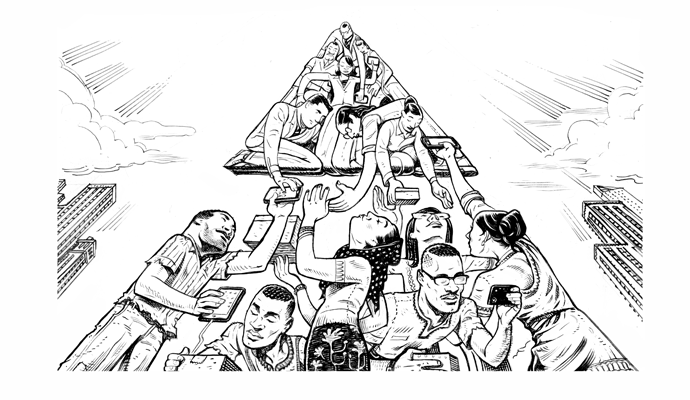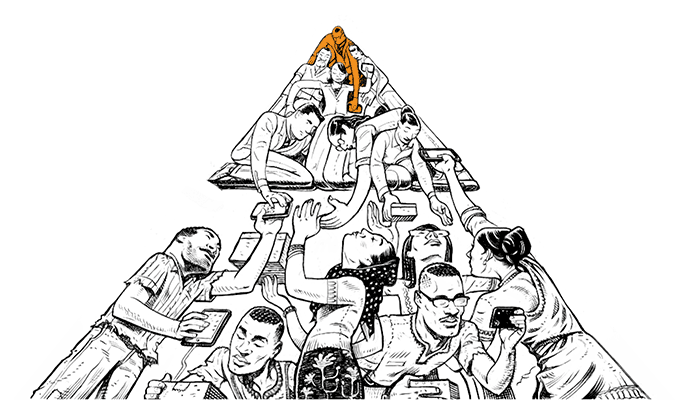The fortune at the bottom of the pyramid
Low-income markets present a prodigious opportunity for the world’s wealthiest companies — to seek their fortunes and bring prosperity to the aspiring poor.
 |
|
Illustration by Marco Ventura
|
s+b celebrating 25 years: In January 2002, C.K. Prahalad and Stuart Hart, professors at the University of Michigan and North Carolina, respectively, urged leaders to imagine the world’s 4 billion poorest people as potential consumers — and described precisely how they could engage them profitably. The prophetic article was followed by the best-selling 2004 book of the same title. In 2019, Deepa Prahalad, C.K. Prahalad’s daughter, updated a portion of the argument in s+b.
With the end of the Cold War, the former Soviet Union and its allies, as well as China, India, and Latin America, opened their closed markets to foreign investment in a cascading fashion. Although this significant economic and social transformation has offered vast new growth opportunities for multinational corporations (MNCs), its promise has yet to be realized.
First, the prospect of millions of “middle-class” consumers in developing countries, clamoring for products from MNCs, was wildly oversold. To make matters worse, the Asian and Latin American financial crises have greatly diminished the attractiveness of emerging markets. As a consequence, many MNCs worldwide slowed investments and began to rethink risk–reward structures for these markets. This retreat could become even more pronounced in the wake of the terrorist attacks in the United States last September.
The lackluster nature of most MNCs’ emerging-market strategies over the past decade does not change the magnitude of the opportunity, which is in reality much larger than previously thought. The real source of market promise is not the wealthy few in the developing world, or even the emerging middle-income consumers: It is the billions of aspiring poor who are joining the market economy for the first time.
This is a time for MNCs to look at globalization strategies through a new lens of inclusive capitalism. For companies with the resources and persistence to compete at the bottom of the world economic pyramid, the prospective rewards include growth, profits, and incalculable contributions to humankind. Countries that still don’t have the modern infrastructure or products to meet basic human needs are an ideal testing ground for developing environmentally sustainable technologies and products for the entire world.
Furthermore, MNC investment at “the bottom of the pyramid” means lifting billions of people out of poverty and desperation, averting the social decay, political chaos, terrorism, and environmental meltdown that is certain to continue if the gap between rich and poor countries continues to widen.
Doing business with the world’s 4 billion poorest people — two-thirds of the world’s population — will require radical innovations in technology and business models. It will require MNCs to reevaluate price–performance relationships for products and services. It will demand a new level of capital efficiency and new ways of measuring financial success. Companies will be forced to transform their understanding of scale, from a “bigger is better” ideal to an ideal of highly distributed small-scale operations married to world-scale capabilities.
In short, the poorest populations raise a prodigious new managerial challenge for the world’s wealthiest companies: selling to the poor and helping them improve their lives by producing and distributing products and services in culturally sensitive, environmentally sustainable, and economically profitable ways.
Four Consumer Tiers
At the very top of the world economic pyramid are 75 to 100 million affluent Tier 1 consumers from around the world. (See Exhibit 1.) This is a cosmopolitan group composed of middle- and upper-income people in developed countries and the few rich elites from the developing world. In the middle of the pyramid, in Tiers 2 and 3, are poor customers in developed nations and the rising middle classes in developing countries, the targets of MNCs’ past emerging-market strategies.
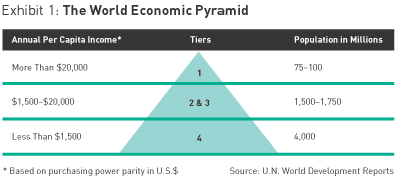
Now consider the 4 billion people in Tier 4, at the bottom of the pyramid. Their annual per capita income — based on purchasing power parity in U.S. dollars — is less than $1,500, the minimum considered necessary to sustain a decent life. For well over a billion people — roughly one-sixth of humanity — per capita income is less than $1 per day.
Even more significant, the income gap between rich and poor is growing. According to the United Nations, the richest 20 percent in the world accounted for about 70 percent of total income in 1960. In 2000, that figure reached 85 percent. Over the same period, the fraction of income accruing to the poorest 20 percent in the world fell from 2.3 percent to 1.1 percent.
This extreme inequity of wealth distribution reinforces the view that the poor cannot participate in the global market economy, even though they constitute the majority of the population. In fact, given its vast size, Tier 4 represents a multitrillion-dollar market. According to World Bank projections, the population at the bottom of the pyramid could swell to more than 6 billion people over the next 40 years, because the bulk of the world’s population growth occurs there.
The perception that the bottom of the pyramid is not a viable market also fails to take into account the growing importance of the informal economy among the poorest of the poor, which by some estimates accounts for 40 to 60 percent of all economic activity in developing countries. Most Tier 4 people live in rural villages, or urban slums and shantytowns, and they usually do not hold legal title or deed to their assets (e.g., dwellings, farms, businesses). They have little or no formal education and are hard to reach via conventional distribution, credit, and communications. The quality and quantity of products and services available in Tier 4 is generally low. Therefore, much like an iceberg with only its tip in plain view, this massive segment of the global population — along with its massive market opportunities — has remained largely invisible to the corporate sector.
Fortunately, the Tier 4 market is wide open for technological innovation. Among the many possibilities for innovation, MNCs can be leaders in leapfrogging to products that don’t repeat the environmental mistakes of developed countries over the last 50 years. Today’s MNCs evolved in an era of abundant natural resources and thus tended to make products and services that were resource-intensive and excessively polluting. The United States’ 270 million people — only about 4 percent of the world’s population — consume more than 25 percent of the planet’s energy resources. To re-create those types of consumption patterns in developing countries would be disastrous.
We have seen how the disenfranchised in Tier 4 can disrupt the way of life and safety of the rich in Tier 1 — poverty breeds discontent and extremism. Although complete income equality is an ideological pipe dream, the use of commercial development to bring people out of poverty and give them the chance for a better life is critical to the stability and health of the global economy and the continued success of Western MNCs.
The Invisible Opportunity
Among the top 200 MNCs in the world, the overwhelming majority are based in developed countries. U.S. corporations dominate, with 82; Japanese firms, with 41, are second, according to a list compiled in December 2000 by the Washington, D.C.–based Institute for Policy Studies. So it is not surprising that MNCs’ views of business are conditioned by their knowledge of and familiarity with Tier 1 consumers. Perception of market opportunity is a function of the way many managers are socialized to think and the analytical tools they use. Most MNCs automatically dismiss the bottom of the pyramid because they judge the market based on income or selections of products and services appropriate for developed countries.
To appreciate the market potential of Tier 4, MNCs must come to terms with a set of core assumptions and practices that influence their view of developing countries. We have identified the following as widely shared orthodoxies that must be reexamined:
- Assumption #1 The poor are not our target consumers because with our current cost structures, we cannot profitably compete for that market.
- Assumption #2 The poor cannot afford and have no use for the products and services sold in developed markets.
- Assumption #3 Only developed markets appreciate and will pay for new technology. The poor can use the previous generation of technology.
- Assumption #4 The bottom of the pyramid is not important to the long-term viability of our business. We can leave Tier 4 to governments and nonprofits.
- Assumption #5 Managers are not excited by business challenges that have a humanitarian dimension.
- Assumption #6 Intellectual excitement is in developed markets. It is hard to find talented managers who want to work at the bottom of the pyramid.
Each of these key assumptions obscures the value at the bottom of the pyramid. It is like the story of the person who finds a $20 bill on the sidewalk. Conventional economic wisdom suggests if the bill really existed, someone would already have picked it up! Like the $20 bill, the bottom of the pyramid defies conventional managerial logic, but that doesn’t mean it isn’t a large and unexplored territory for profitable growth. Consider the drivers of innovation and opportunities for companies in Tier 4. (See Exhibit 2.) MNCs must recognize that this market poses a major new challenge: how to combine low cost, good quality, sustainability, and profitability.
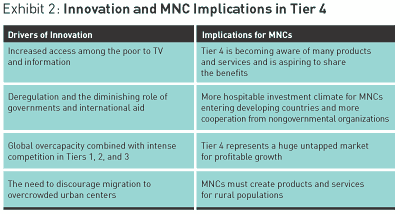
Furthermore, MNCs cannot exploit these new opportunities without radically rethinking how they go to market. Exhibit 3 suggests some (but by no means all) areas where an entirely new perspective is required to create profitable markets in Tier 4.
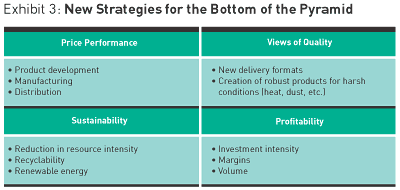
Tier 4 Pioneers
Hindustan Lever Ltd. (HLL), a subsidiary of Great Britain’s Unilever PLC and widely considered the best-managed company in India, has been a pioneer among MNCs exploring markets at the bottom of the pyramid. For more than 50 years, HLL has served India’s small elite who could afford to buy MNC products. In the 1990s, a local firm, Nirma Ltd., began offering detergent products for poor consumers, mostly in rural areas. In fact, Nirma created a new business system that included a new product formulation, low-cost manufacturing process, wide distribution network, special packaging for daily purchasing, and value pricing.
HLL, in typical MNC fashion, initially dismissed Nirma’s strategy. However, as Nirma grew rapidly, HLL could see its local competitor was winning in a market it had disregarded. Ultimately, HLL saw its vulnerability and its opportunity: In 1995, the company responded with its own offering for this market, drastically altering its traditional business model.
HLL’s new detergent, called Wheel, was formulated to substantially reduce the ratio of oil to water in the product, responding to the fact that the poor often wash their clothes in rivers and other public water systems. HLL decentralized the production, marketing, and distribution of the product to leverage the abundant labor pool in rural India, quickly creating sales channels through the thousands of small outlets where people at the bottom of the pyramid shop. HLL also changed the cost structure of its detergent business so it could introduce Wheel at a low price point.
Today, Nirma and HLL are close competitors in the detergent market, with 38 percent market share each, according to IndiaInfoline.com, a business intelligence and market research service. Unilever’s own analysis of Nirma and HLL’s competition in the detergent business reveals even more about the profit potential of the marketplace at the bottom of the pyramid. (See Exhibit 4.)
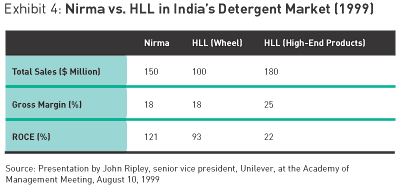
Contrary to popular assumptions, the poor can be a very profitable market — especially if MNCs change their business models. Specifically, Tier 4 is not a market that allows for the traditional pursuit of high margins; instead, profits are driven by volume and capital efficiency. Margins are likely to be low (by current norms), but unit sales can be extremely high. Managers who focus on gross margins will miss the opportunity at the bottom of the pyramid; managers who innovate and focus on economic profit will be rewarded.
Nirma has become one of the largest branded detergent makers in the world. Meanwhile, HLL, stimulated by its emergent rival and its changed business model, registered a 20 percent growth in revenues per year and a 25 percent growth in profits per year between 1995 and 2000. Over the same period, HLL’s market capitalization grew to $12 billion — a growth rate of 40 percent per year. HLL’s parent company, Unilever, also has benefited from its subsidiary’s experience in India. Unilever transported HLL’s business principles (not the product or the brand) to create a new detergent market among the poor in Brazil, where the Ala brand has been a big success. More important, Unilever has adopted the bottom of the pyramid as a corporate strategic priority.
As the Unilever example makes clear, the starting assumption must be that serving Tier 4 involves bringing together the best of technology and a global resource base to address local market conditions. Cheap and low-quality products are not the goal. The potential of Tier 4 cannot be realized without an entrepreneurial orientation: The real strategic challenge for managers is to visualize an active market where only abject poverty exists today. It takes tremendous imagination and creativity to engineer a market infrastructure out of a completely unorganized sector.
Serving Tier 4 markets is not the same as serving existing markets better or more efficiently. Managers first must develop a commercial infrastructure tailored to the needs and challenges of Tier 4. Creating such an infrastructure must be seen as an investment, much like the more familiar investments in plants, processes, products, and R&D.
Further, contrary to more conventional investment strategies, no firm can do this alone. Multiple players must be involved, including local governmental authorities, nongovernmental organizations (NGOs), communities, financial institutions, and other companies. Four elements — creating buying power, shaping aspirations, improving access, and tailoring local solutions — are the keys to a thriving Tier 4 market. (See Exhibit 5.)
Each of these four elements demands innovation in technology, business models, and management processes. And business leaders must be willing to experiment, collaborate, empower locals, and create new sources of competitive advantage and wealth.
Creating Buying Power
According to the International Labor Organization’s World Employment Report 2001, nearly a billion people — roughly one-third of the world’s work force — are either underemployed or have such low-paying jobs that they cannot support themselves or their families. Helping the world’s poor elevate themselves above this desperation line is a business opportunity to do well and do good. To do so effectively, two interventions are crucial — providing access to credit, and increasing the earning potential of the poor. A few farsighted companies have already begun to blaze this trail with startlingly positive results.
Commercial credit historically has been unavailable to the very poor. Even if those living in poverty had access to a bank, without collateral it is hard to get credit from the traditional banking system. As Peruvian economist Hernando de Soto demonstrates in his pathbreaking work, The Mystery of Capital: Why Capitalism Triumphs in the West and Fails Everywhere Else, commercial credit is central to building a market economy. Access to credit in the U.S. has allowed people of modest means to systematically build their equity and make major purchases, such as houses, cars, and education.
The vast majority of the poor in developing countries operate in the “informal” or extralegal economy, since the time and cost involved in securing legal title for their assets or incorporation of their microenterprises is prohibitive. Developing countries have tried governmental subsidies to free the poor from the cycle of poverty, with little success. Even if the poor were able to benefit from government support to start small businesses, their dependence on credit from local moneylenders charging usurious rates makes it impossible to succeed. Local moneylenders in Mumbai, India, charge interest rates of up to 20 percent per day. This means that a vegetable vendor who borrows Rs.100 ($2.08) in the morning must return Rs.120 ($2.50) in the evening.
Extending credit to the poor so they can elevate themselves economically is not a new idea. Consider how I.M. Singer & Company, founded in 1851, provided credit as a way for millions of women to purchase sewing machines. Very few of those women could have afforded the steep $100 price tag, but most could afford a payment of $5 per month.
The same logic applies on a much larger scale in Tier 4. Consider the experience of the Grameen Bank Ltd. in Bangladesh, one of the first in the world to apply a microlending model in commercial banking. Started just over 20 years ago by Muhammad Yunus, then a professor in the Economics Department at Chittagong University, Bangladesh, Grameen Bank pioneered a lending service for the poor that has inspired thousands of microlenders, serving 25 million clients worldwide, in developing countries and wealthy nations, including the United States and Great Britain.
Grameen Bank’s program is designed to addresses the problems of extending credit to lowest-income customers — lack of collateral, high credit risk, and contractual enforcement. Ninety-five percent of its 2.3 million customers are women, who, as the traditional breadwinners and entrepreneurs in rural communities, are better credit risks than men. Candidates for loans must have their proposals thoroughly evaluated and supported by five nonfamily members of the community. The bank’s sales and service people visit the villages frequently, getting to know the women who have loans and the projects in which they are supposed to invest. In this way, lending due diligence is accomplished without the mountain of paperwork and arcane language common in the West.
With 1,170 branches, Grameen Bank today provides microcredit services in more than 40,000 villages, more than half the total number in Bangladesh. As of 1996, Grameen Bank had achieved a 95 percent repayment rate, higher than any other bank in the Indian subcontinent. However, the popularity of its services has also spawned more local competitors, which has cut into its portfolio and shrunk its profits over the past few years.
In addition, Grameen Bank’s rate of return is not easy to assess. Historically, the bank was an entirely manual, field-based operation, a structure that undercut its efficiency. Today, spin-offs such as Grameen Telecom (a provider of village phone service) and Grameen Shakti (a developer of renewable energy sources) are helping Grameen Bank build a technology infrastructure to automate its processes. As the bank develops its online business model, profitability should increase dramatically, highlighting the importance of information technology in the acceleration of the microcredit revolution.
Perhaps the most pertinent measure of Grameen Bank’s success is the global explosion of institutional interest in microlending it has stimulated around the world. In South Africa, where 73 percent of the population earns less than R5,000 ($460) per month, according to a 2001 World Bank study, retail banking services for low-income customers are becoming one of the most competitive and fast-growing mass markets. In 1994, Standard Bank of South Africa Ltd., Africa’s leading consumer bank, launched a low-cost, volume-driven e-banking business, called AutoBank E, to grow revenue by providing banking services to the poor. Through the use of 2,500 automated teller machines (ATMs) and 98 AutoBank E-centres, Standard now has the largest presence in South Africa’s townships and other under-serviced areas of any domestic bank. As of April 2001, Standard served nearly 3 million low-income customers and is adding roughly 60,000 customers per month, according to South Africa’s Sunday Times.
Standard does not require a minimum income of customers opening an AutoBank E account, although they must have some regular income. People who have never used a bank can open an account with a deposit of as little as $8. Customers are issued an ATM card and shown how to use it by staff who speak a variety of African dialects. A small flat fee is charged for each ATM transaction. An interest-bearing “savings purse” is attached to every account to encourage poor customers to save. Interest rates on deposits are low, but superior to keeping cash in a jar. Sunday Times also reported that Standard Bank is considering a loan program for low-income clients.
Computerization of microlending services not only makes the overall operation more efficient, but also makes it possible to reach many more people — lending money to individuals with no collateral and no formal address. Since there is lower overhead and little paperwork, AutoBank’s costs are 30 to 40 percent lower than those at traditional branches.
At the 1999 Microcredit Summit, the United Nations, in conjunction with several major MNCs, such as Citigroup Inc. and Monsanto Company, set a goal of making basic credit available to the 100 million poorest families in the world by the year 2005. Unfortunately, the success of this undertaking has been slowed by high transaction costs, a lack of automation, and poor information and communications infrastructures in rural areas.
To address these issues and accelerate the development of microlending, French banker Jacques Attali, the founding president of the European Bank for Reconstruction and Development and a former chief aide of French President François Mitterand during the 1980s, has created PlaNet Finance. Its Web site, www.planetfinance.org, links thousands of microcredit groups worldwide into a network to help microbanks share solutions and lower costs.
Ultimately, the development of an automated solution for tracking and processing the millions of small loans associated with microlending should be possible. If processing and transaction costs can be reduced enough, they can then be bundled together and sold in the secondary market to multinational financial institutions like Citigroup. This would greatly expand the capital available for microlending beyond the current pool from donors and governments.
In the United States, microlending has also taken root over the past decade in poor urban neighborhoods. For example, the ShoreBank Corporation, formerly South Shore Bank, has demonstrated the profitability of banking for the poor in Chicago’s troubled South Side. Project Enterprise, a Grameen-like program based in New York City, is aimed at minority entrepreneurs.
Several multinational banks are beginning to offer microbanking services in developing countries. Citigroup, for instance, is experimenting in Bangalore, India, with 24/7 services for customers with as little as a $25 on deposit. Initial results are very positive.
Shaping Aspirations
Sustainable product innovations initiated in Tier 4, and promoted through consumer education, will not only positively influence the choices of people at the bottom of the pyramid, but may ultimately reshape the way Americans and others in Tier 1 live. Indeed, in 20 years, we may look back to see that Tier 4 provided the early market pull for disruptive technologies that replaced unsustainable technologies in developed countries and advanced the fortunes of MNCs with foresight.
For example, Unilever’s HLL subsidiary has tackled the lack of practical, inexpensive, low-energy-consuming refrigeration in India. HLL’s laboratories developed a radically different approach to refrigeration that allows ice cream to be transported across the country in standard nonrefrigerated trucks. The system allows quantum reductions in electricity use and makes dangerous and polluting refrigerants unnecessary. As a bonus, the new system is cheaper to build and use.
Electricity, water, refrigeration, and many other essential services are all opportunities in developing countries. A U.S.-based NGO, the Solar Electric Light Fund (SELF), has creatively adapted technology and applied microcredit financing to bring electrical service to people in remote villages in Africa and Asia who otherwise would spend money to burn hazardous kerosene, candles, wood, or dung for their light and cooking. SELF’s rural electrification system is based on small-scale on-site power generation using renewable resources. A revolving loan fund gives villagers the financial means to operate these electrical systems themselves, also creating jobs. Since its founding in 1990, SELF has launched projects in China, India, Sri Lanka, Nepal, Vietnam, Indonesia, Brazil, Uganda, Tanzania, South Africa, and the Solomon Islands.
The success of SELF and other NGOs focused on small-scale distributed energy solutions has begun to attract the attention of Western companies such as the U.S.’s Plug Power Inc. (fuel cells) and Honeywell Inc. (microturbines). They see the logic in moving into a wide-open market in Tier 4 rather than trying to force their technology prematurely into applications for the developed markets, where incumbents and institutions stand in their way. With several billion potential customers around the world, investments in such innovations should be well worth it.
Improving Access
Because Tier 4 communities are often physically and economically isolated, better distribution systems and communication links are essential to development of the bottom of the pyramid. Few of the large emerging-market countries have distribution systems that reach more than half of the population. (Hence the continued dependence of the poorest consumers on local products and services and moneylenders.) As a consequence, few MNCs have designed their distribution systems to cater to the needs of poor rural customers.
Creative local companies, however, lead the way in effective rural distribution. In India, for instance, Arvind Mills has introduced an entirely new delivery system for blue jeans. Arvind, the world’s fifth-largest denim manufacturer, found Indian domestic denim sales limited. At $40 to $60 a pair, the jeans were not affordable to the masses, and the existing distribution system reached only a few towns and villages. So Arvind introduced “Ruf & Tuf” jeans — a ready-to-make kit of jeans components (denim, zipper, rivets, and a patch) priced at about $6. Kits were distributed through a network of thousands of local tailors, many in small rural towns and villages, whose self-interest motivated them to market the kits extensively. Ruf & Tuf jeans are now the largest-selling jeans in India, easily surpassing Levi’s and other brands from the U.S. and Europe.
MNCs can also play a role in distributing the products of Tier 4 enterprises in Tier 1 markets, giving bottom-of-the-pyramid enterprises their first links to international markets. Indeed, it is possible through partnerships to leverage traditional knowledge bases to produce more sustainable, and in some cases superior, products for consumption by Tier 1 customers.
Anita Roddick, CEO of The Body Shop International PLC, demonstrated the power of this strategy in the early 1990s through her company’s “trade not aid” program of sourcing local raw material and products from indigenous people.
More recently, the Starbucks Corporation, in cooperation with Conservation International, has pioneered a program to source coffee directly from farmers in the Chiapas region of Mexico. These farms grow coffee beans organically, using shade, which preserves songbird habitat. Starbucks markets the product to U.S. consumers as a high-quality, premium coffee; the Mexican farmers benefit economically from the sourcing arrangement, which eliminates intermediaries from the business model. This direct relationship also improves the local farmers’ understanding and knowledge of the Tier 1 market and its customer expectations.
Information poverty may be the single biggest roadblock to sustainable development. More than half of humanity has yet to make a single phone call. However, where telephones and Internet connections do exist, for the first time in history, it is possible to imagine a single, interconnected market uniting the world’s rich and poor in the quest for truly sustainable economic development. The process could transform the “digital divide” into a “digital dividend.”
Ten years ago, Sam Pitroda, currently chairman and CEO of London-based Worldtel Ltd., a company created by a telecommunications union to fund telecom development in emerging markets, came to India with the idea of “rural telephones.” His original concept was to have a community telephone, operated by an entrepreneur (usually a woman) who charged a fee for the use of the telephone and kept a percentage as wages for maintaining the telephone. Today, from most parts of India, it is possible to call anyone in the world.
Other entrepreneurs have introduced fax services, and some are experimenting with low-cost e-mail and Internet access. These communication links have dramatically altered the way villages function and how they are connected to the rest of the country and the world. With the emergence of global broadband connections, opportunities for information-based business in Tier 4 will expand significantly.
New ventures such as CorDECT in India and Celnicos Communications in Latin America are developing information technology and business models suited to the particular requirements of the bottom of the pyramid. Through shared-access models (e.g., Internet kiosks), wireless infrastructure, and focused technology development, companies are dramatically reducing the cost of being connected. For example, voice and data connectivity typically costs companies $850 to $2,800 per line in the developed world; CorDECT has reduced this cost to less than $400 per line, with a goal of $100 per line, which would bring telecommunications within reach of virtually everyone in the developing world.
Recognizing an enormous business and development opportunity, Hewlett-Packard Company has articulated a vision of “world e-inclusion,” with a focus on providing technology, products, and services appropriate to the needs of the world’s poor. As part of this strategy, HP has entered into a venture with the MIT Media Lab and the Foundation for Sustainable Development of Costa Rica — led by former President Jose Maria Figueres Olsen — to develop and implement “telecenters” for villages in remote areas. These digital town centers provide modern information technology equipment with a high-speed Internet connection at a price that is affordable, through credit vehicles, at the village level.
Bringing such technology to villages in Tier 4 makes possible a number of applications, including tele-education, telemedicine, microbanking, agricultural extension services, and environmental monitoring, all of which help to spur microenterprise, economic development, and access to world markets. This project, named Lincos, is expected to spread from today’s pilot sites in Central America and the Caribbean to Asia, Africa, and Central Europe.
Tailoring Local Solutions
As we enter the new century, the combined sales of the world’s top 200 MNCs equal nearly 30 percent of total world gross domestic product. Yet these same corporations employ less than 1 percent of the world’s labor force. Of the world’s 100 largest economies, 51 are economies internal to corporations. Yet scores of Third World countries have suffered absolute economic stagnation or decline.
If MNCs are to thrive in the 21st century, they must broaden their economic base and share it more widely. They must play a more active role in narrowing the gap between rich and poor. This cannot be achieved if these companies produce only so-called global products for consumption primarily by Tier 1 consumers. They must nurture local markets and cultures, leverage local solutions, and generate wealth at the lowest levels on the pyramid. Producing in, rather than extracting wealth from, these countries will be the guiding principle.
To do this, MNCs must combine their advanced technology with deep local insights. Consider packaging. Consumers in Tier 1 countries have the disposable income and the space to buy in bulk (e.g., 10-pound boxes of detergent from superstores like Sam’s Club) and shop less frequently. They use their spending money to “inventory convenience.” Tier 4 consumers, strapped for cash and with limited living space, shop every day, but not for much. They can’t afford to stock up on household items or be highly selective about what they buy; they look for single-serve packaging. But consumers with small means also have the benefit of experimentation. Unburdened by large quantities of product, they can switch brands every time they buy.
Already in India, 30 percent of personal care products and other consumables, such as shampoo, tea, and cold medicines, are sold in single-serve packages. Most are priced at Rs. 1 (about 1¢). Without innovation in packaging, however, this trend could result in a mountain of solid waste. Dow Chemical Company and Cargill Inc. are experimenting with an organic plastic that would be totally biodegradable. Such packaging clearly has advantages in Tier 4, but it could also revolutionize markets at all four tiers of the world pyramid.
For MNCs, the best approach is to marry local capabilities and market knowledge with global best practices. But whether an initiative involves an MNC entering Tier 4 or an entrepreneur from Tier 4, the development principles remain the same: New business models must not disrupt the cultures and lifestyles of local people. An effective combination of local and global knowledge is needed, not a replication of the Western system.
The development of India’s milk industry has many lessons for MNCs. The transformation began around 1946, when the Khira District Milk Cooperative, located in the state of Gujarat, set up its own processing plant under the leadership of Verghese Kurien and created the brand Amul, today one of the most recognized in the country.
Unlike the large industrial dairy farms of the West, in India, milk originates in many small villages. Villagers may own only two to three buffaloes or cows each and bring their milk twice a day to the village collection center. They are paid every day for the milk they deliver, based on fat content and volume. Refrigerated vans transport the milk to central processing plants, where it is pasteurized. Railroad cars then transport the milk to major urban centers.
The entire value chain is carefully managed, from the village-based milk production to the world-scale processing facilities. The Khira District cooperative provides such services to the farmers as veterinary care and cattle feed. The cooperative also manages the distribution of pasteurized milk, milk powder, butter, cheese, baby food, and other products. The uniqueness of the Amul cooperative is its blending of decentralized origination with the efficiencies of a modern processing and distribution infrastructure. As a result, previously marginal village farmers are earning steady incomes and being transformed into active market participants.
Twenty years ago, milk was in short supply in India. Today, India is the world’s largest producer of milk. According to India’s National Dairy Development Board, the country’s dairy cooperative network now claims 10.7 million individual farmer member–owners, covers 96,000 village-level societies, includes 170 milk-producer unions, and operates in more than 285 districts. Milk production has increased 4.7 percent per year since 1974. The per capita availability of milk in India has grown from 107 grams to 213 grams per day in 20 years.
Putting It All Together
Creating buying power, shaping aspirations, improving access, and tailoring local solutions — the four elements of the commercial infrastructure for the bottom of the pyramid are intertwined. Innovation in one leverages innovation in the others. Corporations are only one of the actors; MNCs must work together with NGOs, local and state governments, and communities.
Yet someone must take the lead to make this revolution happen. The question is, Why should it be MNCs?
Even if multinational managers are emotionally persuaded, it is not obvious that large corporations have real advantages over small, local organizations. MNCs may never be able to beat the cost or responsiveness of village entrepreneurs. Indeed, empowering local entrepreneurs and enterprises is key to developing Tier 4 markets. Still, there are several compelling reasons for MNCs to embark on this course:
• Resources. Building a complex commercial infrastructure for the bottom of the pyramid is a resource- and management-intensive task. Developing environmentally sustainable products and services requires significant research. Distribution channels and communication networks are expensive to develop and sustain. Few local entrepreneurs have the managerial or technological resources to create this infrastructure.
• Leverage. MNCs can transfer knowledge from one market to another — from China to Brazil or India — as Avon, Unilever, Citigroup, and others have demonstrated. Although practices and products have to be customized to serve local needs, MNCs, with their unique global knowledge base, have an advantage that is not easily accessible to local entrepreneurs.
• Bridging. MNCs can be nodes for building the commercial infrastructure, providing access to knowledge, managerial imagination, and financial resources. Without MNCs as catalysts, well-intentioned NGOs, communities, local governments, entrepreneurs, and even multilateral development agencies will continue to flounder in their attempts to bring development to the bottom. MNCs are best positioned to unite the range of actors required to develop the Tier 4 market.
• Transfer. Not only can MNCs leverage learning from the bottom of the pyramid, but they also have the capacity to transfer innovations up-market all the way to Tier 1. As we have seen, Tier 4 is a testing ground for sustainable living. Many of the innovations for the bottom can be adapted for use in the resource- and energy-intensive markets of the developed world.
It is imperative, however, that managers recognize the nature of business leadership required in the Tier 4 arena. Creativity, imagination, tolerance for ambiguity, stamina, passion, empathy, and courage may be as important as analytical skill, intelligence, and knowledge. Leaders need a deep understanding of the complexities and subtleties of sustainable development in the context of Tier 4. Finally, managers must have the interpersonal and intercultural skills to work with a wide range of organizations and people.
MNCs must build an organizational infrastructure to address opportunity at the bottom of the pyramid. This means building a local base of support, reorienting R&D to focus on the needs of the poor, forming new alliances, increasing employment intensity, and reinventing cost structures. These five organizational elements are clearly interrelated and mutually reinforcing.
• Build a local base of support. Empowering the poor threatens the existing power structure. Local opposition can emerge very quickly, as Cargill Inc. found in its sunflower-seed business in India. Cargill’s offices were twice burned, and the local politicians accused the firm of destroying locally based seed businesses. But Cargill persisted. Through Cargill’s investments in farmer education, training, and supply of farm inputs, farmers have significantly improved their productivity per acre of land. Today, Cargill is seen as the friend of the farmer. Political opposition has vanished.
To overcome comparable problems, MNCs must build a local base of political support. As Monsanto and General Electric Company can attest, the establishment of a coalition of NGOs, community leaders, and local authorities that can counter entrenched interests is essential. Forming such a coalition can be a very slow process. Each player has a different agenda; MNCs have to understand these agendas and create shared aspirations. In China, this problem is less onerous: The local bureaucrats are also the local entrepreneurs, so they can easily see the benefits to their enterprise and their village, town, or province. (See “Profits and Perils in China, Inc.,” First Quarter 2002.) In countries such as India and Brazil, such alignment does not exist. Significant discussion, information sharing, the delineation of benefits to each constituency, and sensitivity to local debates is necessary.
• Conduct R&D focused on the poor. It is necessary to conduct R&D and market research focused on the unique requirements of the poor, by region and by country. In India, China, and North Africa, for example, research on ways to provide safe water for drinking, cooking, washing, and cleaning is a high priority. Research must also seek to adapt foreign solutions to local needs. For example, a daily dosage of vitamins can be added to a wide variety of food and beverage products. For corporations that have distribution and brand presence throughout the developing world, such as Coca-Cola Company, the bottom of the pyramid offers a vast untapped market for such products as water and nutritionals.
Finally, research must identify useful principles and potential applications from local practices. In Tier 4, significant knowledge is transmitted orally from one generation to the next. Being respectful of traditions but willing to analyze them scientifically can lead to new knowledge. The Body Shop’s creative CEO, Ms. Roddick, built a business predicated on understanding the basis for local rituals and practices. For example, she observed that some African women use slices of pineapple to cleanse their skin. On the surface, this practice appears to be a meaningless ritual. However, research showed active ingredients in pineapple that cleared away dead skin cells better than chemical formulations.
MNCs must develop research facilities in emerging markets such as China, India, Brazil, Mexico, and Africa, although few have made a big effort so far. Unilever is an exception; it operates highly regarded research centers in India, employing more than 400 researchers dedicated to the problems of “India-like markets.”
• Form new alliances. MNCs have conventionally formed alliances solely to break into new markets; now they need to broaden their alliance strategies. By entering into alliances to expand in Tier 4 markets, MNCs gain insight into developing countries’ culture and local knowledge. At the same time, MNCs improve their own credibility. They may also secure preferred or exclusive access to a market or raw material. We foresee three kinds of important relationships: Alliances with local firms and cooperatives (such as the Khira District Milk Cooperative); alliances with local and international NGOs (like Starbucks’s alliance with Conservation International in coffee); and alliances with governments (e.g., Merck & Company’s recent alliance in Costa Rica to foster rain forest preservation in exchange for bioprospecting rights).
Given the difficulty and complexity of constructing business models dependent on relationships with national or central governments (e.g., large infrastructure development), we envision more alliances at the local and regional level. To succeed in such alliances, MNC managers must learn to work with people who may not have the same agenda or the same educational and economic background as they do. The challenge and payoff is how to manage and learn from diversity — economic, intellectual, racial, and linguistic.
• Increase employment intensity. MNCs accustomed to Tier 1 markets think in terms of capital intensity and labor productivity. Exactly the opposite logic applies in Tier 4. Given the vast number of people at the bottom of the pyramid, the production and distribution approach must provide jobs for many, as in the case of Ruf & Tuf jeans from Arvind Mills: It employed an army of local tailors as stockers, promoters, distributors, and service providers, even though the cost of the jeans was 80 percent below that of Levi’s. As Arvind demonstrated, MNCs need not employ large numbers of people directly on their payroll, but the organizational model in Tier 4 must increase employment intensity (and incomes) among the poor and groom them to become new customers.
• Reinvent cost structures. Managers must dramatically reduce cost levels relative to those in Tier 1. To create products and services the poor can afford, MNCs must reduce their costs significantly — to, say, 10 percent of what they are today. But this cannot be achieved by fine-tuning the current approaches to product development, production, and logistics. The entire business process must be rethought with a focus on functionality, not on the product itself. For example, financial services need not be distributed only through branch offices open from 9 a.m. to 5 p.m. Such services can be provided at a time and place convenient to the poor consumer — after 8 p.m. and at their homes. Cash-dispensing machines can be placed in safe areas — police stations and post offices. Iris recognition used as a security device could substitute for the tedious personal-identification number and card for identification.
Lowering cost structures also forces a debate on ways to reduce investment costs. This will inevitably lead to greater use of information technology to develop production and distribution systems. As noted, village-based phones are already transforming the pattern of communications throughout the developing world. Add the Internet, and we have a whole new way of communicating and creating economic development in poor, rural areas. Creative use of IT will emerge in these markets as a means to dramatically lower the costs associated with access to products and services, distribution, and credit management.
A Common Cause
The emergence of the 4 billion people who make up the Tier 4 market is a great opportunity for MNCs. It also represents a chance for business, government, and civil society to join together in a common cause. Indeed, we believe that pursuing strategies for the bottom of the pyramid dissolves the conflict between proponents of free trade and global capitalism on one hand, and environmental and social sustainability on the other.
Yet the products and services currently offered to Tier 1 consumers are not appropriate for Tier 4, and accessing this latter market will require approaches fundamentally different from those even in Tiers 2 and 3. Changes in technology, credit, cost, and distribution are critical prerequisites. Only large firms with global reach have the technological, managerial, and financial resources to dip into the well of innovations needed to profit from this opportunity.
New commerce in Tier 4 will not be restricted to businesses filling such basic needs as food, textiles, and housing. The bottom of the pyramid is waiting for high-tech businesses such as financial services, cellular telecommunications, and low-end computers. In fact, for many emerging disruptive technologies (e.g., fuel cells, photovoltaics, satellite-based telecommunications, biotechnology, thin-film microelectronics, and nanotechnology), the bottom of the pyramid may prove to be the most attractive early market.
So far, three kinds of organizations have led the way: local firms such as Amul and Grameen Bank; NGOs such as the World Resources Institute, SELF, The Rainforest Alliance, The Environmental Defense Fund, and Conservation International, among others; and a few MNCs such as Starbucks, Dow, Hewlett-Packard, Unilever, Citigroup, DuPont, Johnson & Johnson, Novartis, and ABB, and global business partnerships such as the World Business Council for Sustainable Business Development. But to date, NGOs and local businesses with far fewer resources than the MNCs have been more innovative and have made more progress in developing these markets.
It is tragic that as Western capitalists we have implicitly assumed that the rich will be served by the corporate sector, while governments and NGOs will protect the poor and the environment. This implicit divide is stronger than most realize. Managers in MNCs, public policymakers, and NGO activists all suffer from this historical division of roles. A huge opportunity lies in breaking this code — linking the poor and the rich across the world in a seamless market organized around the concept of sustainable growth and development.
Collectively, we have only begun to scratch the surface of what is the biggest potential market opportunity in the history of commerce. Those in the private sector who commit their companies to a more inclusive capitalism have the opportunity to prosper and share their prosperity with those who are less fortunate. In a very real sense, the fortune at the bottom of the pyramid represents the loftiest of our global goals. ![]()
Reprint No. 02106
| Authors
C.K. Prahalad, cprahalad@aol.com C.K. Prahalad is the Harvey C. Fruehauf Professor of Business Administration at the University of Michigan Business School, Ann Arbor. He is also the founder and chairman of Praja Inc., a pioneer company in interactive event experiences, based in San Diego, Calif. Stuart L. Hart, slhart@unc.edu Stuart L. Hart is professor of strategic management, Sarah Graham Kenan Distinguished Scholar, and codirector of the Center for Sustainable Enterprise at the University of North Carolina’s Kenan–Flagler Business School. |


